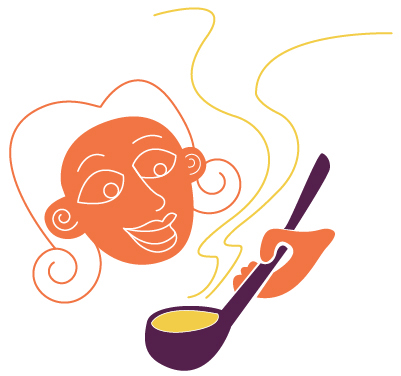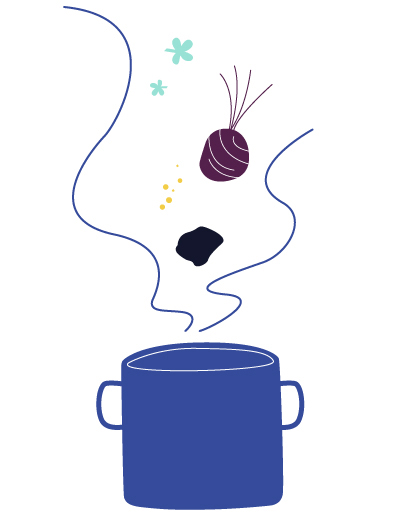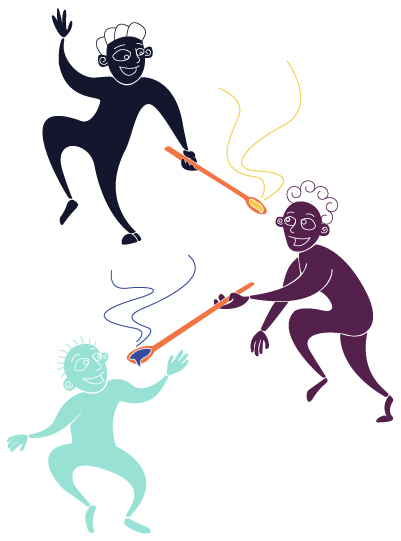Dancing the Soup
W e’re doing a soup dance on the 5th floor of the Apotex building at Baycrest Health Sciences. Shula Strassfeld is leading a group of residents and caregivers in the dancing, and I’m passing around a wooden spoon and inviting them to tell soup stories. The residents, many of them diagnosed with Alzheimer’s, have what I think of as dreamentia. Conversations often take surprising twists, and we’re definitely in a realm where the fluid connectivity of dreams is more prevalent than the logic of everyday discourse.

Soup is a good theme on this particular day. As the spoon travels around the circle, two of the staff tell us how to cook Filipino soup (the herbs can be hard to get in Canada), and we hear about Becky’s legendary chicken soup (always made with an old chicken, which has more flavour – “like us,” someone murmurs, and giggles ensue), and Abe avers his delight in every soup he’s ever tasted. I ask him what his favorite soup is, and there’s a long pause, and I realize my mistake immediately; nouns and naming can be a challenge on the fifth floor. Then Abe answers, in his unhurried, easy manner, “I eat my soup without the names.”
Abe’s agile and creative response makes excellent sense. He stayed in the conversation rather than feeling defeated by my request for a name. With deft wit, he also reminded us that the soupness of soup is what matters: to hell with the names, as long as the soup keeps its savour.
All of this reminded me of a folktale, which I told the group. (As Baycrest’s storyteller-in-residence, everything reminds me of a story.)
A poor woman had five children. They had no food or money. She came to a neighbour and asked, “Do you have any extra food?” “No,” said the neighbour, “we are just as poor as you.” That’s what all the neighbours in the village told her. So she said to her five children, “Since we can’t find food here in the village, let’s go out on the road and eat whatever we find.” The first thing they found was a stone, so she picked it up and told the kids they were going home to make soup with it.
The poor woman brought the stone home and put it in a soup pot. The children filled the pot with water and threw some salt and pepper in. She lit the fire in her yard and began to stir the pot. She dipped her wooden spoon in, tasted it, and said in a voice clear enough to be heard next door, “Mmmmm … delicious!”
One of the neighbours wandered over and asked her what she was cooking.
“Stone soup,” she said. “It will be ready soon and I’ll invite you over to try it.”
“Stone soup?” asked the puzzled neighbour. “How do you make it?”
“You start by boiling a stone,” she said. “Mind you, if I had a bit of onion it might taste even better.”
“Ai, you just reminded me … I have some onions at home. If I bring them, can I taste the soup?”
“Of course!”
You see how the story goes. Everyone in the village offers something for the pot, and everyone gathers for the feast. They had the best party anyone could remember, and afterwards the neighbours walked home saying, “Imagine, such a wonderful soup, and she made it from a stone …”
You probably know a version of this folktale, which is told all around the world. One thing about making art with people with dementia: every experience is fresh and unanticipated, even a story as old as this one. And after the words came the dance, which takes an even more direct route to the heart, especially when words and sentences have become baffling. We danced the hungry children and the clever soup cook and the poor villagers, at first cautious and then generous. We danced knocking on a neighbour’s door, feeling our hunger, walking on a dusty road, finding a stone. We danced the vegetables, and we danced chopping, stirring, seasoning, tasting, sharing. At the end, we danced the fiesta in the poor woman’s yard as the whole village gathered to celebrate their collective creation.
Perhaps the wonder of making soup from a stone (with a little help from our friends) isn’t so very different from how

Abe, Becky, and everyone else on the fifth floor keep making connections in a world where it’s hard to name the soup – and the people – you know and love so well. In the strange, new realm of Alzheimer’s the signage is scarce, no GPS shows you the way home, your neighbours are just as beleaguered as you are, and only the astonishing patience and compassion of your family and caregivers make daily life possible.
One story always seems to lead to another, and when the wooden spoon came back to me I told a last story.

A man dreamed of heaven and hell. Hell was a vast dining hall filled with round tables, Starving people sat at the tables, and in front of them were bowls of delicious-smelling chicken soup. The problem was, they each had spoons with such long handles that they couldn’t eat the soup that was in front of them. It was a true nightmare, and the man woke up shaken by his vision. Then he went back to sleep and dreamed of heaven. Heaven looked just like hell. Round tables, delicious soup, long-handled spoons. Yet in heaven, people were feasting and laughing. He woke up. He was puzzled. How was it they were able to eat in heaven and in hell they starved?
I asked the group what they thought was the difference between heaven and hell. A Filipino woman pointed out that the spoons of Filipinos living in Toronto reached all the way from Toronto to Manila. She remits most of her salary to her family back home. On Sundays, when she skypes home, she’s happy to see her children and parents eating chicken adobo and delicious lumpia spring rolls, and she’s careful not to let the webcam catch the dish of sardines she’s about to eat, sign of the sacrifice she’s making every day she lives overseas. Abe, who likes to eat his soup even without the names, hazarded a guess to my riddle: “Maybe they fed each other?”
©2018 STORYCARE. Website by furia.ca